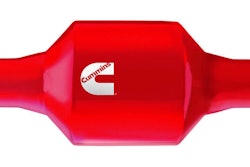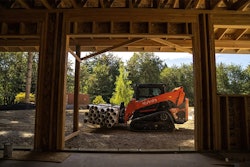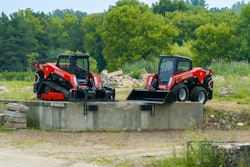 Atlas Copco introduced three new breaker models -- HB-2000, HB-3100 and HB-4700 -- at Bauma 2010 in Munich, Germany
Atlas Copco introduced three new breaker models -- HB-2000, HB-3100 and HB-4700 -- at Bauma 2010 in Munich, GermanyAt Bauma 2010, Atlas Copco introduced three new heavy-hydraulic breaker models with PowerAdapt and optimized power-to-weight ratio.
The HB 2000 — with its service weight of 2000 kg — offers 10-percent more power than its predecessor, the HB 200. The new HB 3100 and HB 4700 with a service weight of 3100 and 4700 kg, respectively, deliver 5 percent and 13 percent more power than their predecessor models.
In doing so, Atlas Copco sticks to the principle of developing and building attachments offering an improved power-to-weight ratio. The same performance can be achieved with a smaller attachment and carrier unit. Investment and maintenance costs are reduced. More power also means a higher strain against which the attachments are protected by proven and new product features.
All three hydraulic breakers are equipped with the PowerAdapt system which shuts down the breaker in case the oil pressure is too high.
Torsten Treger, product line manager medium & heavy breakers for Atlas Copco, says this feature is particularly useful when the hydraulic breaker is used on different carrier units.
“Hydraulic breakers can generally be hydraulically overloaded if the carrier’s oil pressure has the wrong setting,” Treger says in a written statement. “In order to ensure that our customers can make full use of the equipment in terms of efficiency and power, we have equipped the entire range of heavy-duty hydraulic breakers with PowerAdapt.”
With an improper carrier oil pressure setting, conventional pressure relief valves as the ones frequently used in hydraulic breakers continuously drain oil into the tank and therefore waste precious energy. This affects the efficiency and profitability of the equipment.
The improved guide system of the hydraulic breakers provides a better stability and resistance.
“After all hydraulic breakers are subject to tough operating conditions,“ Treger adds in the press release. “A new retaining bar provides a better protection especially in the lower part of the hydraulic breaker which has to take a lot of wear and tear. The service window and the recesses for the lateral slewing screw couplings have been reinforced. The Non-Dust version of the three new breaker models are furnished with the all-round wear protection which all of the dust versions of the HB series of hydraulic breakers already feature.”
All proven features of Atlas Copco’s heavy-duty hydraulic breaker line are also found in the three new models: the VibroSilenced System to protect operators against noise and vibrations, AutoControl to adapt the blow frequency and impact energy to the rock hardness as well as the integrated automatic lubrication system ContiLube II. With StartSelect the operator can influence the starting and shutdown behaviour of the hydraulic breaker. And with the optional DustProtector the hydraulic breaker is protected against dust and rock particles penetrating the lower breaker part.
Technical data: HB 2000 HB 3100 HB 4700
Service weight kg 2000 3100 4700
Carrier weight class t 22-38 32-52 45-80
Oil flow l/min 150-190 210 – 270 260-340
Operating pressure bar 160-180 160 – 180 160-180
Number of blows bpm 300-600 280 – 560 280-520












